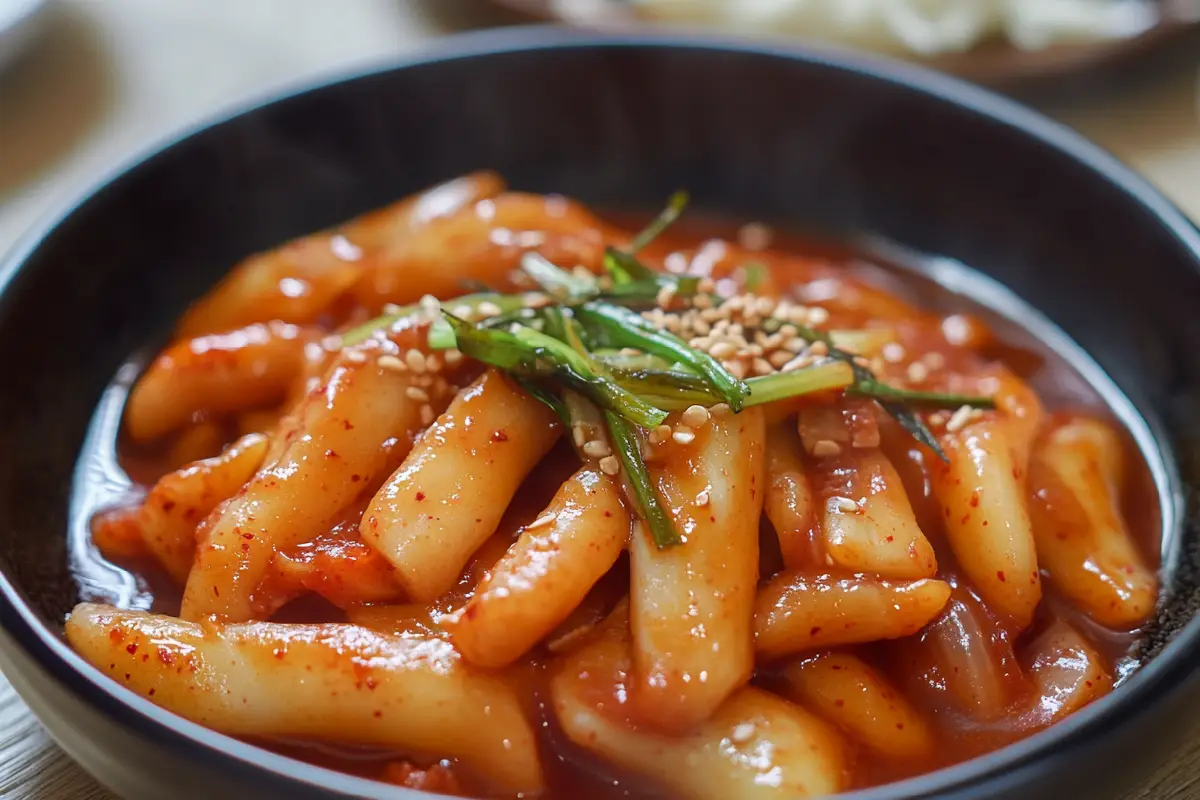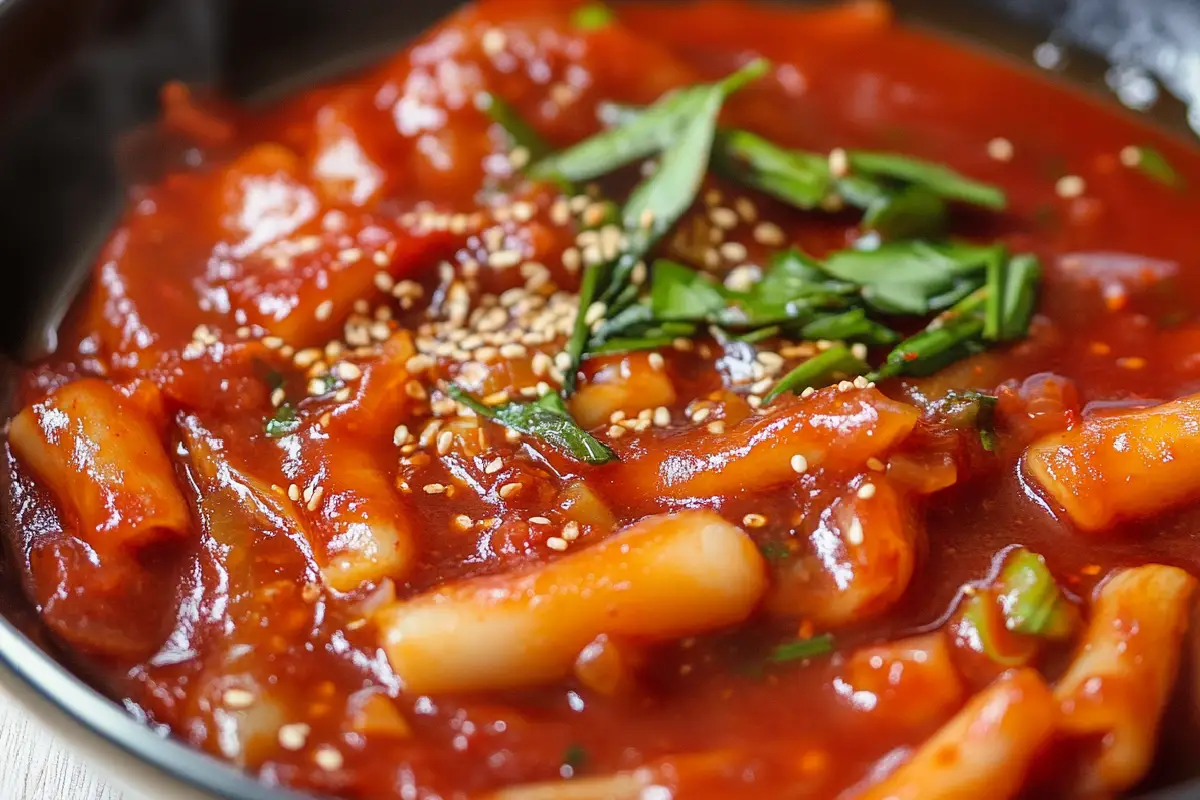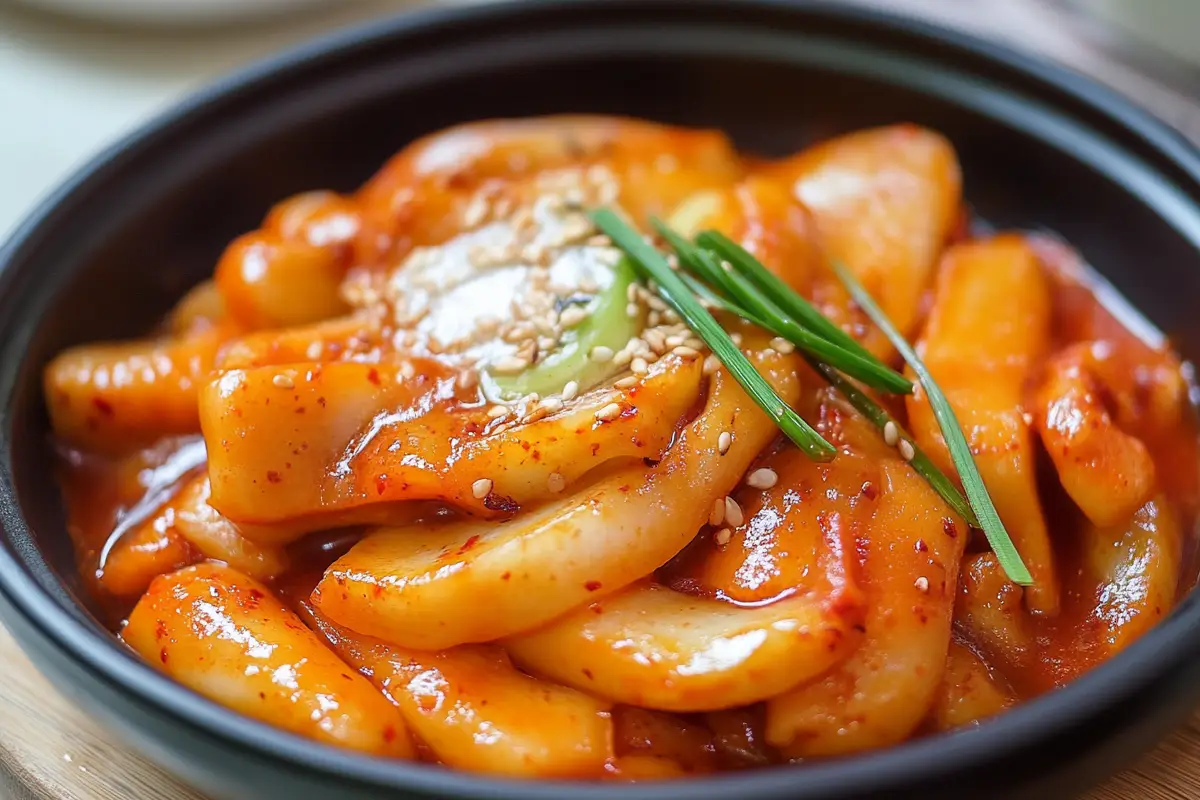Tteokbokki is one of Korea’s most iconic and popular street foods, featuring chewy rice cakes (tteok) smothered in a rich, flavorful sauce. The tteokbokki sauce is what truly makes this dish shine, as it perfectly balances sweet, spicy, and savory notes. It’s a flavor-packed condiment that has found its way into the hearts of food lovers across the world. Whether you’re discovering tteokbokki for the first time or are a seasoned fan, understanding the ingredients and variations of tteokbokki sauce can help you enjoy this dish to its fullest potential.
Traditional Ingredients of Tteokbokki Sauce
At the core of tteokbokki sauce are five essential ingredients that give it its unique character. These ingredients work together to create the sauce’s distinctive combination of heat, sweetness, and umami.
-
Gochujang (Korean Red Chili Paste): This is the backbone of tteokbokki sauce. Gochujang is a fermented chili paste made from chili peppers, glutinous rice, fermented soybeans, and salt. It’s spicy, but it also has a slight sweetness and deep umami flavor thanks to the fermentation process. Gochujang can vary in heat levels depending on the brand, so you can adjust the spice level of your sauce by choosing a mild or hot version. For a deeper dive into gochujang, read more here.
-
Soy Sauce: While gochujang provides heat and depth, soy sauce adds saltiness and enhances the umami in the sauce. It helps round out the flavors by bringing a savory, slightly sweet quality that complements the spice.
-
Sugar: One of the signature characteristics of tteokbokki sauce is its balance between spicy and sweet. Sugar is an essential ingredient because it tempers the heat from the gochujang and enhances the sauce’s overall flavor. You can use regular granulated sugar, but some recipes call for alternatives like brown sugar or honey for added depth.
-
Garlic: Fresh garlic adds aromatic sharpness and depth to the sauce. The garlic brings out the earthiness in the gochujang and adds complexity to the sauce’s overall flavor profile.
-
Water or Stock: The sauce’s consistency can be adjusted with water, but for a more authentic and flavorful version, traditional recipes use anchovy stock. This stock is made by boiling dried anchovies with kelp, imparting a deep umami flavor to the sauce. Using stock instead of water enhances the savory elements of the sauce.
Additional Ingredients & Variations
While the five traditional ingredients form the foundation of tteokbokki sauce, several other ingredients can be added to personalize and enhance the sauce.
-
Gochugaru (Korean Chili Flakes): If you want an extra spicy kick, you can add gochugaru, which are Korean chili flakes. This ingredient not only increases the heat level but also adds texture to the sauce.
-
Fish Cakes (Eomuk): One of the most common additions to tteokbokki is fish cakes, which absorb the flavors of the sauce while adding their own subtle sweetness and texture.
-
Rice Syrup (Mulyeot): Mulyeot is a type of Korean rice syrup that adds a glossy finish and extra sweetness to the sauce. It helps create a smooth, silky texture that coats the rice cakes well.
-
Onions & Green Onions: Adding onions and green onions enhances the flavor and freshness of the dish. Onions provide a touch of sweetness as they cook, while green onions bring a mild sharpness that complements the spice of the sauce.
-
Sesame Oil: A small drizzle of sesame oil can add a nutty richness to the sauce, giving it more depth and complexity.
By experimenting with these ingredients, you can create a personalized version of tteokbokki sauce that suits your taste preferences.
Regional and Contemporary Variations of Tteokbokki Sauce

Tteokbokki has evolved from its traditional form into a variety of regional and modern adaptations, each with its own spin on the classic dish. The versatility of tteokbokki sauce allows for endless creativity in the kitchen, leading to the development of new and exciting variations.
Busan-Style Tteokbokki
Busan, a coastal city in South Korea, is known for its unique version of tteokbokki, which often includes fish cakes, boiled eggs, and even seafood. The sauce in Busan-style tteokbokki is typically lighter and less spicy, often incorporating soy sauce as a base rather than relying solely on gochujang. This creates a more balanced and slightly less fiery version of the dish.
Rosé Tteokbokki
One of the more recent and trendy variations of tteokbokki is rosé tteokbokki, which incorporates cream or milk into the sauce. The addition of dairy creates a rich, creamy texture that mellows the heat of the gochujang, resulting in a sauce that is smooth and indulgent. Cheese is often added to enhance the creaminess, making this variation especially popular with younger generations.
Non-Spicy Tteokbokki
Not everyone enjoys the heat of traditional tteokbokki sauce, so there are non-spicy alternatives that use soy sauce or other savory ingredients to create a more mild flavor. Soy-based tteokbokki sauce is often combined with broth or dashi to create a deep, umami-packed sauce that is flavorful but not overpowering. This version is ideal for those who want to enjoy tteokbokki without the spice.
How to Make Tteokbokki Sauce: A Step-by-Step Guide
Now that you understand the core ingredients, here’s a simple, step-by-step guide to making your own tteokbokki sauce at home. This recipe is a great starting point for creating a traditional tteokbokki dish, but feel free to customize it with your favorite variations.
Ingredients:
- 3 tablespoons of gochujang (adjust for spice level)
- 1 tablespoon of soy sauce
- 2 teaspoons of sugar (or to taste)
- 2 cloves of garlic, minced
- 1 cup of water or anchovy stock
- Optional: gochugaru for extra spice, fish cakes, onions, green onions, and sesame oil
Instructions:
-
Mix the Base Ingredients
- In a pot, combine 3 tablespoons of gochujang, 1 tablespoon of soy sauce, 2 teaspoons of sugar, and 2 minced garlic cloves.
-
Add Liquid
- Pour in 1 cup of water or anchovy stock, and stir the mixture until it becomes smooth and evenly blended.
-
Simmer the Sauce
- Bring the sauce to a boil over medium heat, then lower the heat and let it simmer for 10 minutes. This allows the flavors to meld and the sauce to thicken slightly.
-
Adjust Consistency
- If the sauce is too thick, you can add more water or stock to thin it out. If it’s too thin, let it simmer for a few more minutes until it reaches your desired consistency.
-
Add Optional Ingredients
- At this point, you can add fish cakes, onions, or other ingredients you want to include. Let them cook in the sauce until fully heated and coated.
Customizing Tteokbokki Sauce
One of the great things about tteokbokki sauce is how easy it is to customize. Whether you prefer a spicier version or need to make dietary adjustments, there are plenty of ways to adapt the sauce to your taste or dietary needs.
Adjusting Spice Levels
If you’re sensitive to heat, you can easily adjust the spice level of tteokbokki sauce by reducing the amount of gochujang or leaving out the gochugaru. On the other hand, if you love spice, you can add more gochujang or incorporate extra chili flakes for a fiery kick.
Making Vegan Tteokbokki
To make vegan tteokbokki sauce, simply swap out the anchovy stock for vegetable broth and make sure the soy sauce you’re using is vegan. Fish cakes can be replaced with tofu or other plant-based ingredients to maintain the texture while keeping the dish vegan-friendly.
Gluten-Free Tteokbokki
For a gluten-free version, be sure to use a gluten-free gochujang and tamari in place of soy sauce. Some brands of gochujang contain wheat, so check the labels to ensure you’re using a gluten-free version.
Serving Suggestions & Pairing Ideas
Tteokbokki can be served as a snack, street food, or even as a main course. Here are some popular serving suggestions and pairing ideas that complement the spicy, sweet, and savory flavors of the sauce.
- Kimchi: The tangy, fermented flavors of kimchi provide a refreshing contrast to the rich and spicy tteokbokki sauce.
- Boiled Eggs: Many people enjoy adding boiled eggs to their tteokbokki. The eggs soak up the sauce and offer a creamy texture that balances the heat.
- Scallions & Sesame Seeds: For a fresh garnish, top your tteokbokki with chopped scallions and a sprinkle of sesame seeds to add texture and a nutty flavor.
Nutritional Value of Tteokbokki Sauce
Tteokbokki sauce is rich and flavorful, but it’s also possible to adjust it for those who are conscious of their nutritional intake.
Calories
Tteokbokki sauce is relatively low in calories on its own, but the addition of sugar and rice cakes can increase the overall calorie content. If you’re looking for a lighter version, you can reduce the sugar or use a sugar substitute.
Macronutrients
The sauce itself is primarily made up of carbohydrates due to the sugar and gochujang. It’s low in fats and proteins, though adding fish cakes, eggs, or tofu to the dish can boost the protein content.
Healthier Options
For a healthier version, consider using low-sodium soy sauce or reducing the amount of sugar. You can also add more vegetables, such as mushrooms or spinach, to increase the dish’s nutritional value without sacrificing flavor.
FAQs About Tteokbokki Sauce
- What is the difference between gochujang and gochugaru?
Gochujang is a chili paste, while gochugaru is made from dried chili flakes. Gochujang is fermented and provides a deep umami flavor, whereas gochugaru is mainly used for spice and texture. - Can I make tteokbokki sauce without gochujang?
Yes, you can substitute other chili pastes, though the flavor profile will be different. Gochujang has a unique depth that is difficult to replicate with other ingredients. - How do I store leftover tteokbokki sauce?
Leftover sauce can be stored in an airtight container in the refrigerator for up to a week. Reheat it gently on the stove before using it again. - How spicy is tteokbokki sauce?
The spice level depends on the amount of gochujang and gochugaru you use. It can be quite spicy, but you can adjust it to your preference. - What can I use instead of fish cakes in tteokbokki?
You can use tofu, mushrooms, or other plant-based proteins as alternatives to fish cakes.
Conclusion

Tteokbokki sauce is a flavorful combination of gochujang, soy sauce, garlic, and sugar, creating the perfect balance of spicy, sweet, and savory. Whether you’re making a traditional version or experimenting with modern variations, this sauce is versatile and easily customizable. By understanding its core ingredients and preparation methods, you can enjoy this beloved Korean dish in your own kitchen. Try making it yourself and discover the incredible flavors of tteokbokki sauce!
If you’re looking for more recipes, check out this guide on making cheesy mashed potatoes for another comfort food favorite.

